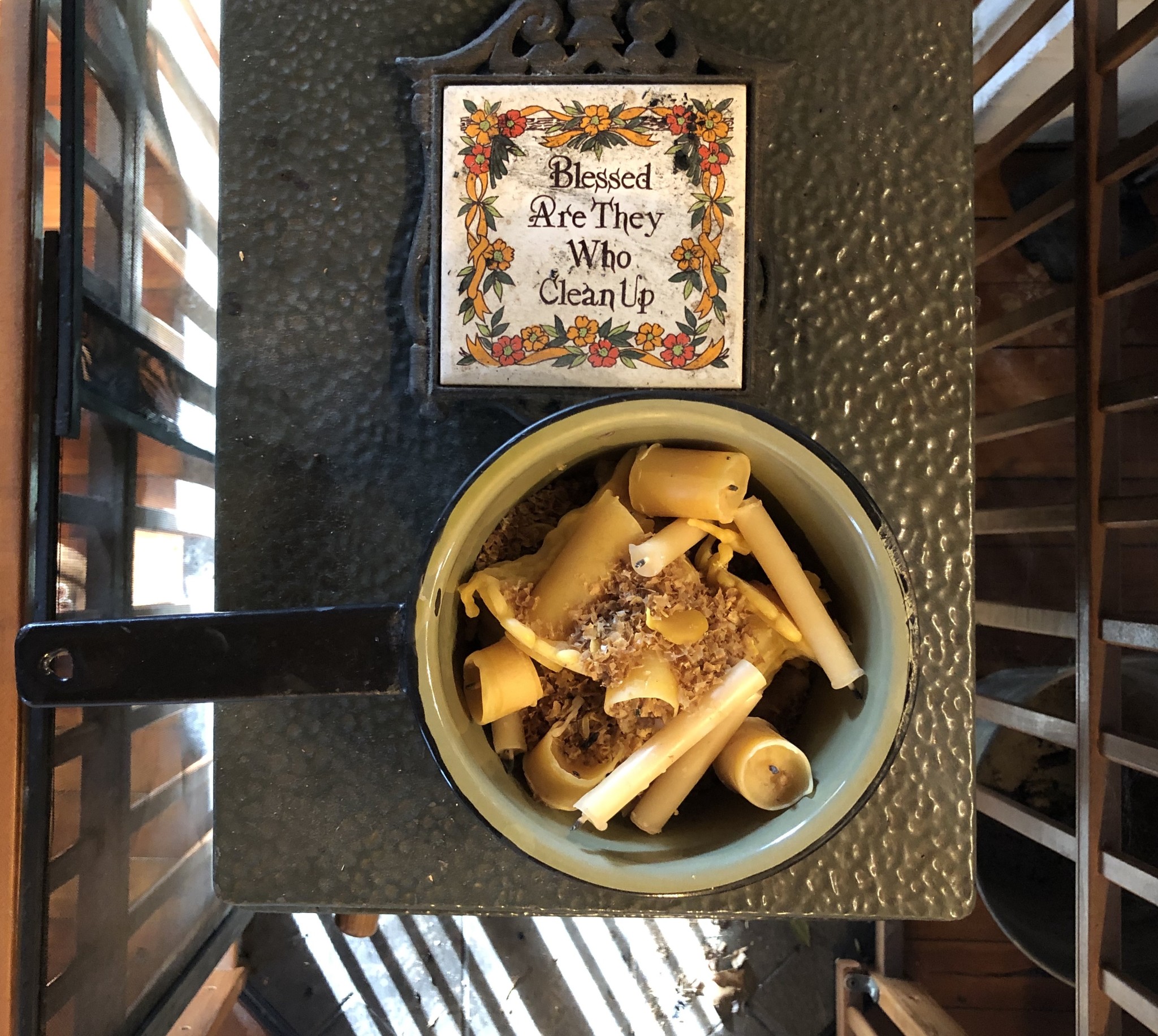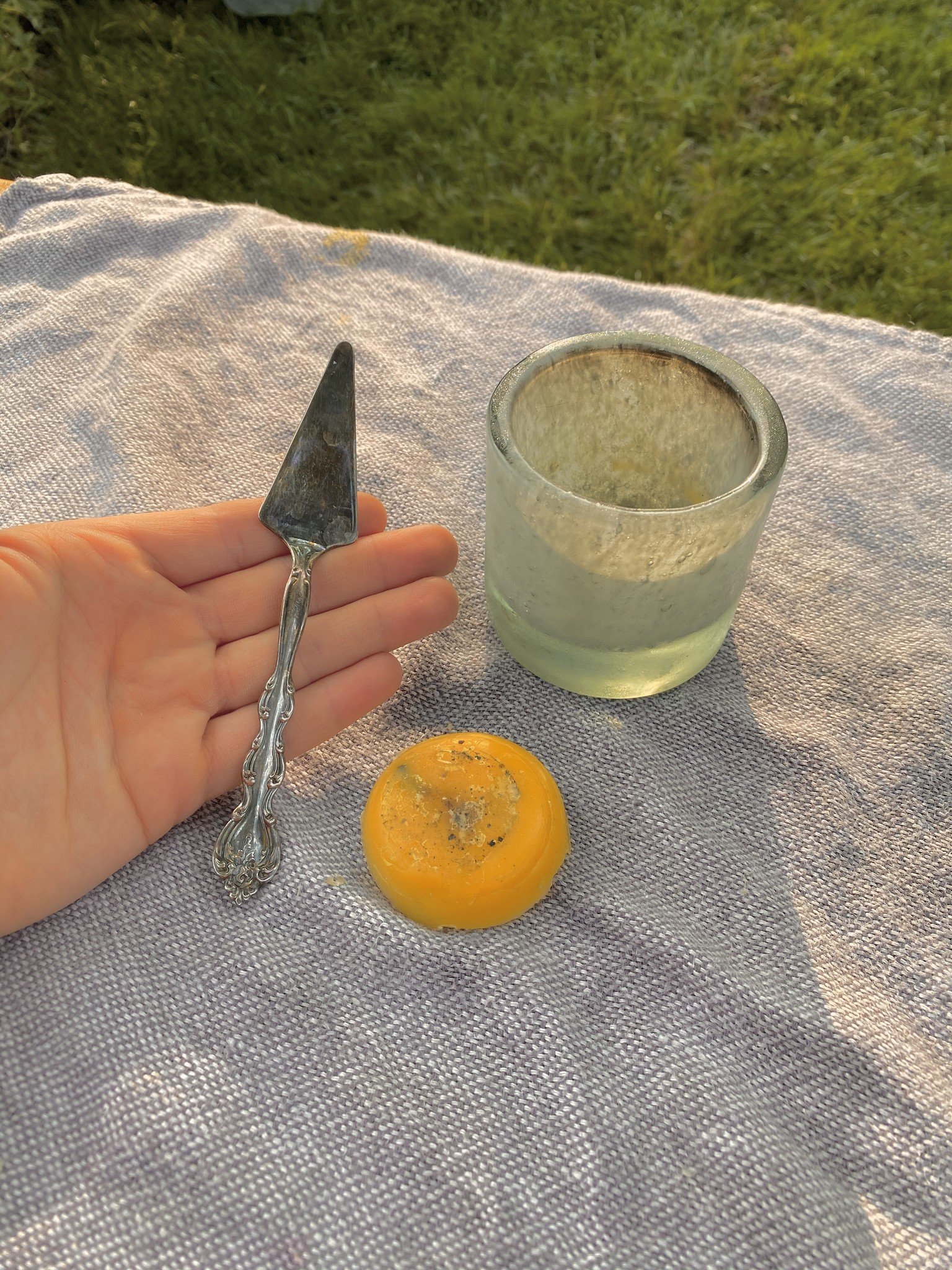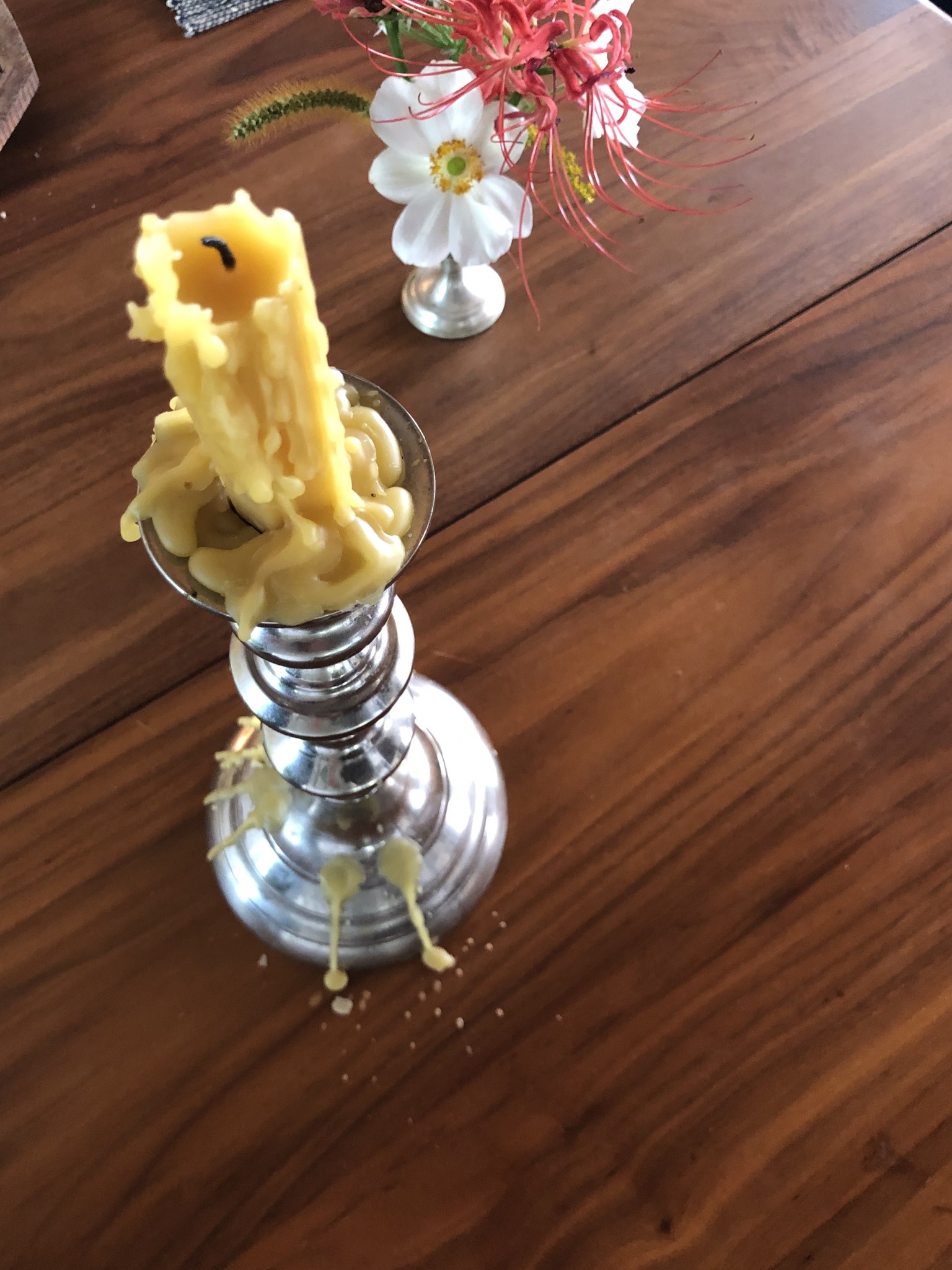How To: Deal With Beeswax
- Posted on
- By Susannah
- Posted in Beeswax, Cleaning, Hot Tips, How To..., Product Care, The Foundry At Home
- 0

Beeswax! It's so incredible! In the beehive, it's the main substance underpinning the mystical queenly architecture. Outside of the hive, it's been used by humans for thousands of years as a sealant, polish, and lubricant, as a crucial ingredient in art supplies, cleaning solutions, and skin care, and—of course—to make candles. The sweet-smelling stuff is sort of miraculous.
There's almost nothing we love more than the flickering golden light of beeswax candles. Beeswax candles smell incredible, offer a rich glow, and burn cleaner, slower, and last longer than synthetic and petroleum-based waxes. The beeswax for our cult-favorite candles is made in the friendly hives at our friend Kate's fourth-generation organic apiary and lovingly hand-rendered, filtered, wicked, and poured just up the road in Grant County. We love these candles and after years of burning them, we have a few tips and tricks for peak-loveliness AND how to deal with the beeswax if it does happen to drip.
First a little bit of candle "etiquette":
- Trim your wick every. single. time. A trimmed wick (down to 1/8"-1/4") allows for the cleanest, brightest, most even burns. You can use a specialized wick trimmer, but small scissors, nail clippers, or even just a tweak with your fingers will do in a pinch. Keeping wicks centered and trimmed makes the candles last longer and burn cleaner.
- For wider pillar candles, burn them all the way across/as close to the edge as possible. Stopping the burn before the wax well *almost* reaches the edge can lead to dripping (especially in tapers), canoeing (when the side gets all whapped out), and tunneling (when the wick burns inefficiently in a deep hole in pillars). While doing this "right" can feel like a bit of a commitment (to wit-Anna burns hers for at least 5 hours the first time she lights them and ideally that long for the next few times) we like to take a zen approach. As Zhuang Zhou says: at the still point in the center of the circle, one can see the infinite in all things. Or, as Ruby says: don't rush it, babe. You'll be bummed if your candle gets wonky and drips wax on the table. Om.
- Avoid drafts and breezes which can lead to uneven burning/spilling/splattering.
- If you DO notice a spill is about to happen, quickly snuff out the flame and give your candle wax a few minutes to re-soldify before re-lighting. It's rare but spills do happen if the wick wanders to one side or your candle is on an uneven surface.
- And a no-nonsense, no-brainer reminder: never leave burning candles unattended and burn candles on non-flammable surfaces.
Ahh, the crickets, the lone woof, the golden light...and an occasional wick adjustment. Your candle should burn in its dead center. The usual culprit for uneven burning is a drafty breeze, but occasionally, the wick can get a little lean on it. This can easily be fixed by pushing the wick back to the center with any nonflammable tool (Anna uses a straightened out paperclip).
DEALING WITH BEESWAX: DRIPS + DRABS
While beeswax candles do legitimately drip less than other types of waxes, sometimes beeswax gets around. Luckily it's actually pretty easy to deal with beeswax on the loose. Here's how!
FREEZE IT
 (also look at Lillian's freezer: just margarita popsicles and spa-day cucumber slices—WHICH SHE CONFIRMS ARE FOR DETECTIVE!!—in a little enamel dish SWOON!)
(also look at Lillian's freezer: just margarita popsicles and spa-day cucumber slices—WHICH SHE CONFIRMS ARE FOR DETECTIVE!!—in a little enamel dish SWOON!)
For beeswax that's stuck in a votive or on a candlestick, pop it in the freezer! Beeswax is very temperature sensitive—when exposed even to just the level of warmth of the palm of the hand, the wax becomes soft and pliable, when put in in the freezer it becomes brittle and easy to pop in, out, or off with the tool of your choice (be it fingernail, small spatula, or fancy pants tiny fairy cake server as seen below).
BOIL IT
An alternative to freezing is boiling. Put your beexwaxy item in a pot of water and bring it to a boil. The wax will liquify and can be wiped out with a piece of paper or a paper towel (be careful! the item, the pot, the water, and the wax will be hot! Also, never take a frozen glass and put HOT stuff in it or vice versa! Flash-transitions for glass of any kind can cause cracks- Love, Your Mothers). If the item still feels waxy, wipe it down with a little bit of vegetable oil and follow up washing with sudsy water.
BLOW DRY IT/ICE CUBE IT
If you get beeswax on a surface you can't boil or pop into the freezer (like the dining room table, say), a warm blowdryer can soften the wax it to the point that it can be gently removed or, depending on the amount of wax and the surface it's on, buffed off. Since removing the softened wax is a gentle process, we like using a warm method for more delicate surfaces (like wood, which also takes kindly to buffing), but if the surface can withstand some light scraping, simply placing an ice cube right on the wax and chipping it off once it gets hard can also do the trick.
IRON IT
Good news for epic-dinner-party-tablecloths: it's pretty simple to get beeswax out of most fabric/textiles using a hot iron. Chip or pick as much beeswax off as possible until you're down to the fibers (an ice cube is helpful here too). Sandwich the fabric between two pieces of paper—our brown Foundry packing paper is perfect for this application* but a brown paper bag or paper towels will work too, we don't recommend newsprint due to ink transfer—and, working from the "back" of the fabric, iron over the waxy area on low heat, moving the paper around so the wax continues to soak into a "fresh" spot. If there is still a slight residue remaining, suds the fabric up and wash as usual. If the fabric is on a sofa or something that can't be tossed in the washer, you can also spot clean any remaining residue by sprinkling baking soda on it and brushing it out.
*For those of us with woodstoves or fireplaces, save the paper! A little crumple of wax-saturated brown Foundry paper is legitimate dream-kindling. Waste not, want not.
SAVING + REPURPOSING BEESWAX
 Foundry Family Beekeeper Susannah re-rendering wax cappings and candle ends on her woodstove last winter.
Foundry Family Beekeeper Susannah re-rendering wax cappings and candle ends on her woodstove last winter.
If you find yourself with a tail-end of a beeswax taper or you've popped a little ring of burnt-end beeswax out of your votive holder, don't toss it! There are loads of fun and plucky all-natural and zero-waste applications for all of your candle butts and wax blurbs.
Disclaimers: If going to be working with beeswax, we recommend keeping dedicated "tools" specifically for that purpose. The basics are a pot, funnel, and strainer. While beeswax is non-toxic and simple to get off of a candlestick, it's a royal pain to deeply clean out of something like a sieve IF you're going to want to use the sieve later for dusting a cake with powdered sugar. Beeswax is (as you can imagine) highly flammable, so if you're processing it over open flame, keep an eye on it. When it's melted, it's also very hot, so be mindful of molten wax. Ok. Onward!
If you find yourself with a lot of leftover beeswax, the best way to process it is re-melting it. If you're doing it on the stovetop, a double boiler ensures max safety. Foundry Family Beekeeper Susannah puts keeps any spent candle ends in the thrift-store enamel pot above and when it's full, she melts it down on her woodstove, strains it through cheesecloth to remove any impurities/old wicks (the cheesecloth itself, in turn, makes a great firestarter), and then does a few different things with it:
- Use old candles to make MORE candles.
- Make your own beeswax wrap.
- Wax canvas for waterproof material.
- Combine with soap shavings and pigments to make crayons.
- Combine with coconut oil and olive oil to make body butter (add calendula and this also makes a great diaper cream).
- Combine with coconut oil or linseed oil to make furniture polish.
- Combine with mineral oil to make butcher-block-style wood conditioner.
- Combine with coconut oil and shea butter to make a Burt's Bees Fakeout Lip Balm.
Not down for melting and alchemy? Don't fret! There are tons of helpful applications for beeswax that require ZERO PROCESSING. Just grab your 'ol candle bottom and get to work! You can literally take any piece of wax and do the following:
- Rub sticky doors, drawers, and drawer rails with beeswax to make them slide in and out easier.
- Lube up sled rails with beeswax for maximum lickety-splitness.
- Rub beeswax on shoes or fabric and hit with a blowdryer for a spot-treating wax waterproofing.
- Apply to metal tools that might spend some time in the elements (hello, beloved garden tools) and buff off to re-up a rust-proof coating.
- Zip a little bit along the teeth of a stubborn zipper to help it get unstuck.
And if you don't feel like doing ANYTHING with the beeswax but don't want to it to go to waste, bring it back to us! We are a happy collection point for Beekeeper Kate to gather and repurpose old beeswax into fresh candles. You can dump a bag of random beeswax on our doorstep any day and we'll know exactly what to do with it!
Want to get some beeswax in your life? Right this way!




Comments
Be the first to comment...